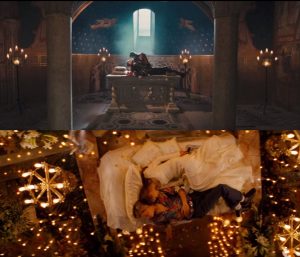
The infamous, tragic deaths of Shakespeare’s star-crossed lovers Romeo of Montague and Juliet Capulet have been capturing the hearts of audiences of many centuries, eliciting fairly high-budget adaptations even in the 1990’s and 2000’s.
The deaths originally occur in Shakespeare’s play in V.III.72-170. The scene starts with Romeo killing Paris and ends after Juliet has killed herself. The Baz Luhrmann’s 1996 adaptation of the play, staring Leonardo DiCaprio and Claire Danes, presents a modern day adaptation of the play, being set in present day (at the time) Verona Beach in the United States. Carlo Carlei’s 2013 versions, staring Hailee Steinfeld and Douglas Booth is set (and filmed in part, according to the movie’s IMDB page) in Verona, Italy. The controversial 1996 adaptation, in spite of its change of setting, harbours much better acting, especially on the part of DiCaprio as Romeo and Danes as Juliet, who deliver much more heartfelt performances than Steinfeld and Booth. The latter’s performances falter during the tragic scene, their supposed suffering seeming shallow and artificial compared to what would be expected for lovers that lost each other. Had Luhrmann stuck to a much more true to the original adaptation, the movie might have been a lot more successful and respected.

Both adaptations take creative liberties, changing both plot and characters’ lines. In Luhrmann’s Romeo+ Juliet, Romeo does not kill Paris. However, perhaps the most significant change in both films is that Juliet wakes up while Romeo is still alive, while in the original play she rises after the poison had already taken her lover’s life. In the 2013 version, Romeo also sees Tybalt’s corpse prior to seeing Juliet, whereas in the play he reaches her first. In the 1996 film, Juliet is alone in the church.
Lines 91-95, 101-106, 112-114 (Romeo’s speech) are the largest sections which both films quote, though both the word order and acting interpretations are fairly different. Luhrmann’s sticks to the original version a lot more closely than Carlei’s, who simplifies and modernizes the language more, even shortening Romeo’s speech by quite a bit. For example, Shakespeare’s lines 91-95 originally read:

“…O my love, my wife!/Death, that hath sucked the honey of thy breath/Hath had no power yet upon thy beauty./Thou art not conquered. Beauty’s ensign yet/Is crimson in thy lips and in thy cheeks,/And death’s pale flag is not advanced there.” (Shakespeare, V.III.91-95)
DiCaprio in Luhrmann: “My love. My wife. Death that hath sucked the honey from thy breath hath no power yet upon thy beauty. Thou art not conquered. Beauty’s ensign is crimson in thy lips and in thy cheeks. And death’s pale flag is not advanced there.”…
Booth in Carlei: “My wife. … Death that has sucked the honey out of your breath has had no power as yet to spoil your beauty”…
As you can see, the 1996 version cuts out the word “yet”, while Carlei trims and moves around a fair amount of the speech.

There are instances where you can tell that the 2013 Romeo and Juliet may have taken inspiration from the preceding version. For example, in both versions there are close up shots of Juliet’s eyes opening while Romeo is starting to drink the poison. While it’s understandable that she had just awakened from a drug-induced sleep, it makes you wonder if Romeo might have been saved if she said something when she woke up, instead of just staring at him while he drinks the poison.

Both scenes end on shots of the two dead lovers on the altar bed, after Steinfeld’s traditional Juliet stabs herself, and Danes’ shoots herself with Romeo’s gun. The 2013 version included the arrival of Friar Laurence and his discussion with Juliet, while the 1996 version again kept the moment focused on the main characters. The only part of Juliet’s speech that both adaptations utilize are “I will kiss thy lips./Haply some poison yet doth hang on them,” (Shakespeare, V.III.164-165) though both change the wording. Danes as Juliet states to a dying DiCaprio “I’ll kiss thy lips lest some poison yet to hang on them,” while Steinfeld expresses “Just one kiss, in case some poison lingers on your lips” over Booth’s freshly dead Romeo.
Two Veronas, two rival households, two different versions of the same tragic love story attempting to tug at audiences’ heartstrings. While Carlei’s version is perhaps easier to follow because it is much more traditional (in terms of setting, costumes etc) to what you would expect a Shakespeare movie to look like. However the acting lacks much depth from Booth and especially Steinfeld that would needed to emit the passion behind the bard’s words. Luhrmann’s bizarre and highly criticized version offers far better performances from young DiCaprio and Danes, whose characters you might actually sympathize with, if you get over the movie’s in-your-face 90’s vibe. (not that there’s anything wrong with the 90’s, of course, except some…style choices)
Works Cited and Sources:
Shakespeare, William. Romeo and Juliet. Ed. Daniel Fischlin. N.p.: Oxford UP, 2013. Print. Shakespeare Made in Canada.
William Shakespeare’s Romeo Juliet. Dir. Baz Luhrmann. Twentieth Century Fox Film Corp., 1996. Web.
Romeo& Juliet. Dir. Carlo Carlei. Relativity Media, 2013. Web.
Screenshots of Carlei’s version from “Romeo and Juliet 2013 – Final Scene B.” YouTube. YouTube, 04 May 2015. Web. 08 June 2016.
Screenshots of Luhrmann’s version from Movieclips. “Romeo Juliet (4/5) Movie CLIP – Romeo Dies (1996) HD.” YouTube. YouTube, 09 Oct. 2015. Web. 08 June 2016., and Movieclips. “Romeo + Juliet (5/5) Movie CLIP – Together in Death (1996) HD.” YouTube. YouTube, 09 Oct. 2015. Web. 08 June 2016.
2013 Romeo and Juliet viewed on Netflix.com
1996 Romeo and Juliet viewed on www.moviesub.net/romeo-juliet-1996/2212.html
Movie Posters found via google.com/images (1996: http://www.impawards.com/1996/posters/william_shakespeares_romeo_and_juliet.jpg) (2013: http://www.imdb.com/media/rm1566628608/tt1645131)
Leave a Reply
You must be logged in to post a comment.